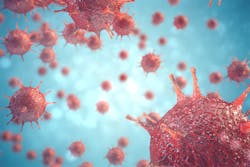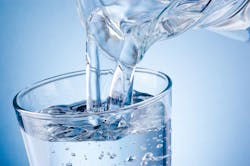Drinking water and wastewater treatment plants play an essential role in removing and inactivating viruses prior to human exposure; these facilities employ a variety of treatment methods that target overall viral communities, including human viral pathogens such as the coronavirus, norovirus, and others. Given the threat that SARS-CoV-2 (the virus that causes COVID-19) poses to public health, it is important to revisit the state of virus removal in water treatment systems and the mechanisms in place that provide communities with safe drinking water. Below, we address the ways in which viruses enter water supplies and the efficacy of virus removal and inactivation by various drinking water and wastewater treatment methods.
Surface water is an important source of drinking water, as many potable water systems rely, at least in part, on water supplies from lakes, rivers, streams, and reservoirs. However, surface water often contains a range of contaminants, including microbial pathogens (e.g., viruses, bacteria, and protozoa) that can pose threats to public health. The Safe Drinking Water Act (SDWA) was enacted in the 1970s to protect public health by regulating the public water supply. To meet the standards set forth by the SDWA, utilities treat source water with a variety of conventional and advanced treatment methods prior to distribution. Though treatment train designs vary among utilities, they each contain multiple levels of physical and chemical processes that remove and/or inactivate viruses — ultimately producing safe, potable water.
Microorganisms found in surface waters come from a variety of sources, including stormwater runoff and wastewater discharges. When wastewater effluent is discharged upstream of drinking water intakes (a process known as “unplanned potable reuse”), wastewater effluent can impact the quality of drinking water sources. Much like the way drinking water is regulated by the SDWA, wastewater discharges are regulated by the Clean Water Act (CWA), which requires a certain level of wastewater treatment prior to discharge.
Wastewater undergoes multiple layers of treatment to reduce the presence of pollutants, such as suspended solids and microorganisms. These treatment requirements stem from the CWA and are intended to prevent incidental ingestion of pathogens and to reduce nutrient loading on water bodies that receive effluent discharges. Wastewater treatment facilities employ physical, chemical, and biological processes. Typical treatment trains include primary treatment with physical screening, grit removal, and settling, and secondary treatment in which microbial communities aid in transforming nutrients to reduce nitrogen and phosphorus loading. These processes are often followed by an additional clarification step and a tertiary disinfection step. Disinfection is intended to inactivate pathogens and commonly involves chlorination but can include ultraviolet (UV) radiation or advanced oxidation processes (AOPs) that effectively inactivate pathogens.
Virus morphology influences how easily different types of viruses can be inactivated by disinfection. Some viruses are covered by an outer envelope that makes them susceptible to being dismantled by disinfectants. Because enveloped viruses such as SARS-CoV-2 and influenza are easier to inactivate in water treatment processes than non-enveloped enteric viruses, they are less likely to persist in treated effluent.
Secondary wastewater treatment processes typically achieve approximately 90-99 percent virus removal or more, while systems that include tertiary treatment can achieve up to 99.99999 percent reduction. Viruses that survive these treatment processes are discharged with treated effluent into receiving water bodies. Pathogen limits for wastewater effluent vary depending on its intended fate. For example, California has adopted regulations for indirect potable reuse (IPR), where highly treated wastewater is introduced into a water body (e.g., a groundwater aquifer or surface water reservoir) that provides a buffer in time and space before the water is withdrawn and treated again for potable use. These IPR projects are required to achieve at least 99.9999999999 percent reduction of viruses (i.e., 12 log reduction).
Given the presence of microbes in surface waters and the possibility of unplanned reuse scenarios, drinking water treatment facilities use conventional and advanced treatment methods to ensure the safety of the water supply. Drinking water facilities that treat surface water typically use a conventional treatment train consisting of coagulation, flocculation, sedimentation and filtration, followed by disinfection. The process of coagulation, flocculation, and sedimentation is effective at removing inorganic and organic contaminants found in natural surface waters and can achieve 90-99 percent virus removal, though removal can be as low as approximately 20 percent depending on virus type and coagulation conditions. Typical filtration performed after the sedimentation step can achieve anywhere from zero to 99.97 percent virus removal, depending on filter media and coagulation pretreatment. Filtration is followed by disinfection, typically with chlorine or chloramine, to inactivate remaining pathogens before water is released to the drinking water distribution system. Chlorine, for example, can achieve 99 percent virus reduction, depending on factors such as water turbidity, the presence of free chlorine, and contact time. Other disinfection processes, such as ozone and UV, can achieve 99 and 99.99 percent inactivation, respectively.
Conventional drinking water treatment methods are effective in producing safe, potable water that meets the 99.99 percent virus reduction criteria mandated by the Surface Water Treatment Rules. Depending on the source water quality, facilities may opt to incorporate advanced treatment methods into their conventional processes to provide a higher level of treatment, such as reverse osmosis and AOPs.
While the presence of viruses in drinking water sources is indeed possible, the risk that viruses, including the SARS-CoV-2 virus, pose to finished drinking water is low — a view echoed by agencies such as CDC, WHO, and EPA. Thanks to the use of multiple treatment steps that combine conventional and advanced methods, drinking water treatment facilities substantially reduce virus loads to produce finished drinking water that is protective of public health. WW
Editor’s Note: Want to dive deeper? Check out our four-part webcast series, Disinfection: Challenges and Opportunities at WaterWorld > Webcasts.
About the Authors: Kasia Grzebyk, PhD is a scientist with Exponent’s Environmental & Earth Sciences Group. She is a water quality scientist by training, with expertise in the production of potable water from alternative sources, including wastewater effluent and contaminated ground and surface waters.
Morgan Petrovich, PhD is an associate with Exponent’s Environmental & Earth Sciences Group. She has a background in environmental engineering with an emphasis on wastewater treatment bioprocesses, drinking water treatment processes, environmental microbiology and genomics, and public health.




